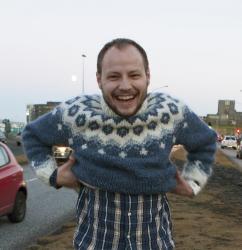
When I was handed ‘The Summerland: The Deceased Describe Their Passing and Reunion in The Other World’ to review, I thought it was a joke (hahaha, give the new guy this ancient book to review, hahaha). The cover design looks like it came straight from the ‘80s: a painting of a First Nations person in a war bonnet, poorly superimposed over a fluorescent rendering of a boat sailing through an open door. Two words in the subtitle were left randomly un-capitalised.
The book was still shrink-wrapped and I wondered how long it had been sitting around the office. I was startled to discover it had first been printed in 2010 and reprinted subsequently; the English translation was released in July 2014. Perhaps I’d fallen into that cliché: books and their covers. So I checked my attitude and read it.
The bad news
‘The Summerland’ appears to be without any kind of structure, meandering aimlessly through multiple subjects and approaches. Author Guðmundur Kristinsson alternates between the first and third person in reference to himself, and random words and passages are bolded throughout. He describes the life of one particular English medium, Horace S. Hambling, in the first 50 pages, before launching into a stream of vignettes on séances and spirits as reported by various mediums. These include reports on the afterlife from the author’s dead son and British soldiers who occupied Iceland during World War II, among many others. The book concludes with a long, episodic narrative description of passing through The Summerland itself as told by the spirit of Einar Loftsson; it comes off as quite similar to John Bunyan’s parable ‘The Pilgrim’s Progress.’
Guðmundur has written books on both Spiritualism (the belief and practice of communicating with spirits) and Icelandic history, and both passions are clear throughout the book. His ability to report history works better in his favour, however. The strongest section of the book is that detailing the history of the British occupation of Iceland, interspersed with reports from beyond by its now passed airmen. The historical passages read lightly and clearly.
His prose is clipped and frank, lending ease to the reader here. At times this style is endearing in its frankness, especially when detailing otherwise wildly farfetched claims such levitation, transfiguration, and conjuring, but more often falls completely flat. Between the allegations and the style, entire paragraphs are dead in the water from the first bland sentence: “Although none of Abraham Lincoln’s biographies state that he was a Spiritualist, it was well-known in his time. His mother was a physic.”
Serving you Joan of Arc realness
I must admit here that I am not the staunchest of realists; I have quite esoteric leanings. I am down with Tarot readings, aura colours, Numerology, vibes, and the like. So I don’t say this lightly. The book is clearly aimed only at those acquainted with and devoted to Spiritualism, making no concessions to any noobs. One is expected to know the difference between healing and trance séances, ether and ectoplasm, a medium’s spirit guide and their special guardian “doorkeeper.”
A few scenes stand out. Guðmundur has a séance with the spirit of Abraham Lincoln, who was convinced to abolish slavery by a medium telling him of the future in the voice of a male spirit. A blind British woman is possessed by the spirit of Leonardo da Vinci to paint a portrait of Horace’s favourite spirit guide, a wildly inaccurate stereotype of a Sioux native named Moon Trail; it is then declared “a live-long study [of] da Vinci” by “specialists at the Tate Gallery in London.” (I haven’t even mentioned the Engrish-speaking Ming Dynasty “Chinaman” guide.)
An Icelandic medium visits France and has a vision of Joan of Arc: “Sitting behind her was a man, a ‘dead’ man, who guided and protected her… She obeyed all his commands. With his help she was able to achieve a great deal…which otherwise would have seemed an impossible task for such a young girl.” Some sections read like fantastically revisionist historical fiction. At one point, a spirit is asked “But were you not amazed?” about passing on; he was. I could ask myself the same of the book. Convinced? Not quite. But amazed? Absolutely.
The good news
Spoiler alert. The good news is that the spirit world sounds quite pleasant. The spirit of the author’s deceased son visits him years later to talk about his spirit girlfriend from Akureyri and their adopted spirit child. Death is described as quite similar to depictions from cartoons: a younger, prettier spirit replica of yourself emerges from the head of your earthly body until your ethereal umbilical cord detaches. You awake in a spirit hospital attended by spirit doctors and nurses, where you get dressed and go move into your spirit life. In Summerland, there are nice jobs, houses, weather, pets, and even tourist cruises to spirit islands, all memories of happiness and fulfilment brought over from life.
For those interested in Spiritualism and undaunted by a hearty peppering of typos and self-published design and editing flaws, you’ve found your encyclopaedia. The book is an undeniable glut of information on the specifics of Spiritualism. But sceptics and fence-sitters are unlikely to be convinced and would be better advised to start their New Age edification with something a little more accessible. Say Eckhart Tolle, or even Patrick Swayze and Demi Moore’s 1990 film ‘Ghost,’ for example.
Buy subscriptions, t-shirts and more from our shop right here!















